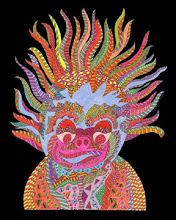New Delhi discovers it may face the threat of homegrown Islamist extremism for the first time.
India is one of the world's most terror-prone countries, with a death toll second only to Iraq, according to a report last year by the National Counterterrorism Center in Washington. India is at constant war with separatists and Maoists rebels. But when it comes to Islamic extremism, New Delhi has always blamed foreign influence—usually Pakistan's. With reason: the militants fighting for Kashmir's independence have extensive links to Pakistan or Bangladesh, where they've set up camps and been nurtured by local intelligence services.
Now that picture may be changing. Shortly before dusk on Sept. 13, Indian news organizations got an e-mail warning that "to dreadfully terrorize you, we are about to devastate your very first metropolitan center." Around the same time, a bomb ripped through a popular marketplace in New Delhi. Within the next hour, four more explosions hit other crowded markets, killing 24 and wounding more than 100. Three more bombs were also located and defused.
The message claimed the attacks were the work of the Indian Mujahedin (IM): a terrorist group unheard of before November 2007, when it took credit for coordinated bombings in three northern cities. The group also claimed responsibility for lethal attacks in Jaipur in May and Ahmadabad in July, and it's suspected of a similar attack in Bangalore. When the IM first appeared, experts thought it was just a front for one of India's known, foreign-sponsored terrorist outfits. But that view has since shifted, and many Indians now fear their country is developing its own, homegrown Islamic terror problem—and that jihadists are finding more and more recruits among the nation's 140 million Muslims.
The IM's "command-and-control seems to be totally local," says Bahukutumbi Raman, a former top official with India's Research and Analysis Wing (RAW), New Delhi's foreign-intelligence branch. So are its grievances, he argues. In e-mails to the Indian media, the IM has denounced the country's discrimination against its Muslim minority and expressed its desire to avenge the 2002 anti-Muslim pogroms in Gujarat and the destruction of a 16th-century mosque by Hindu fanatics in 1992. After the July Ahmadabad attack, the IM insist-ed that the operation was "planned and executed by Indians only," and it urged Pakistan-linked groups not to claim responsibility for it. The IM never even mentioned Kashmir—the central concern of most foreign-linked terrorists—until this month's e-mail.
More ominous, perhaps, is the fact that several people arrested after the Ahmadabad blasts reportedly told authorities they'd attended paramilitary camps in India—not in Pakistan or Bangladesh. Authorities now fear these camps, in the remote forests of Kerala (in India's southwest), and in Madhya Pradesh (in India's heartland), have trained hundreds of radicalized Indians in the past few years.
The exact nature of the IM remains an enigma, however. Most of those arrested are members of the Students' Islamic Movement of India (SIMI), a radical group formed in the late 1970s that advocates turning the country into an Islamic state. The government banned SIMI in 2001 for alleged links to terrorism. But in August a Delhi court ruled the government had failed to prove its case.
Now some experts, including Ajai Sahni of the Institute for Conflict Management in New Delhi, think the IM is a SIMI front that lets SIMI appear nonviolent while secretly using the group as its military wing. They note that this bifurcated structure worked well for other outfits like the PLO, which created the front group Black September in the early 1970s to distance itself from terrorism in Europe.
But not everyone buys the SIMI theory—including the Western intelligence agencies helping the Indian government investigate the attacks. One Western official in New Delhi noted that the Indians have pointed the finger at "the usual suspects" and arrested SIMI activists, but the attacks have continued—suggesting the IM may in fact be a new homegrown group.
The idea that India's Muslims may be radicalizing taps into one of the government's worst nightmares. India's Muslims have historically rejected extreme forms of Islam. But according to a 2006 report, Muslims trail almost every other Indian community in terms of social, economic and educational development, and this could be feeding extremism. Yet New Delhi, fearful of stoking communal animosities, has been loath to acknowledge the growing radicalization. Instead, it has typically blamed attacks on foreign sponsors—and even now has been slow to acknowledge the emergence of purely homegrown Islamic terrorism. Meanwhile, the IM is still out there, perhaps composing the next menacing e-mail.
